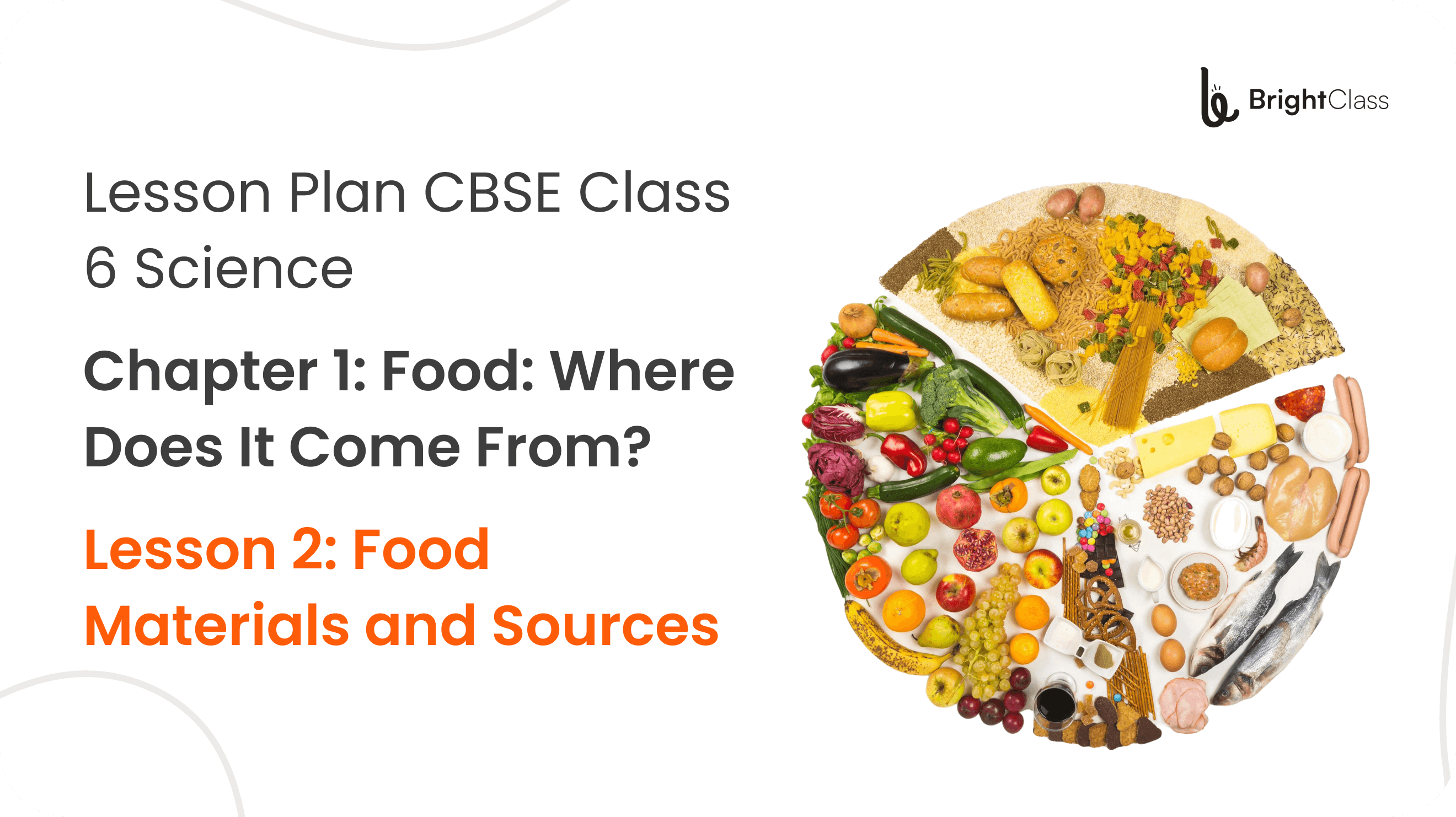
Lesson Plan for CBSE Class 6 Chapter 1: Food: Where Does It Come From? Lesson 2: Food Materials and Sources
The chapter "Food: Where Does It Come From?" in Class 6 Science is important for students. Students can grasp the origins of their food,
comprehend the intricacies of plant and animal products, and appreciate the dynamics of a food chain.
A thoughtfully crafted lesson plan incorporates engaging activities and practical examples, making the learning experience enjoyable and memorable for students. It caters to diverse learning styles, encourages active participation, and stimulates curiosity, fostering a genuine interest in the subject.
A well-organized lesson plan aids students in setting clear expectations, understanding learning objectives, and tracking their progress.
It creates a cohesive learning environment that promotes retention and application of knowledge, empowering students to connect theoretical
concepts with real-world scenarios. In essence, a comprehensive lesson plan enhances the overall educational experience for students, making
the study of "Food: Where Does It Come From?" not just informative but also exciting and relevant to their daily lives.
Lessons in Chapter 1: Food: Where Does It Come From?
- Food variety
- Food materials and sources
- Plant parts and animal products as food
- What do animals eat?
Here is the Lesson Plan for Food Materials and Sources under the chapter Food: Where Does It Come From?
This lesson plan is according to popular 5E’s Framework using the BrightClass application. Try it now for free.
Implementing the 5E instructional framework - Engage, Explore,
Explain, Elaborate, and Evaluate - enhances the effectiveness of a
lesson plan for the "Food: Where Does It Come From?" chapter in
Class 6 Science. By engaging students with compelling introductions,
encouraging exploration of concepts through hands-on activities,
providing clear explanations, fostering elaborate discussions, and
assessing understanding, the 5E model creates a dynamic and
immersive learning experience. This systematic approach ensures that
students actively participate, comprehend, and retain information,
transforming the lesson into a journey of discovery. The 5E
framework tailors education to diverse learning styles, making the
study of food origins not just educational but engaging and
memorable.
Engage
OBJECTIVES:
To introduce the topic of food materials and sources and engage students in the lesson.
HOOK:
Display pictures or actual examples of different types of food such as fruits, vegetables, grains, dairy products, and meats. Ask the students to identify the types of food and share their favorite foods.
PREVIEW:
Explain that in today's lesson, they will be learning about the different components of food materials and sources.
Explore
OBJECTIVES:
To explore and identify different components of food materials and sources.
MATERIALS:
Pictures or samples of different types of food, whiteboard or chart paper, markers
PROCEDURE:
- Show the pictures or samples of different types of food to the students.
- Ask the students to identify and name the different types of food shown.
- Write the names of the food on the whiteboard or chart paper.
- Discuss with the students the different components of food materials and sources, such as fruits, vegetables, grains, dairy products, and meats.
- Have a class discussion on the different sources of food, such as plants, animals, or a combination of both.
CLOSURE:
Summarize the discussion by emphasizing the different components of food materials and sources, and their importance in our diet.
Explain
OBJECTIVES:
To explain in detail the different components of food materials and sources.
MATERIALS:
Whiteboard or chart paper, markers, handout with information on different food components
PROCEDURE:
- Review the different components of food materials and sources discussed in the previous section.
- Introduce the handout with information on different food components.
- Go through the handout with the students, explaining each component in detail.
- Provide examples of food items that belong to each component (e.g. apples and oranges for fruits, rice and bread for grains, etc.).
- Encourage students to ask questions and clarify any doubts they may have.
CLOSURE:
Summarize the key points discussed and emphasize the importance of consuming a balanced diet with all the different components of food materials and sources.
Elaborate
OBJECTIVES:
To further explore the concept of food materials and sources through a group activity.
MATERIALS:
Chart paper, markers, sticky notes
PROCEDURE:
- Divide the class into small groups.
- Give each group a piece of chart paper and markers.
- Instruct the groups to create a mind map or concept map of the different components of food materials and sources.
- Encourage them to include examples of food items and their sources.
- After the groups have finished, have them present their maps to the class.
CLOSURE:
Summarize the key points discussed in the group presentations and highlight any interesting connections or insights made by the students.
Evaluate
OBJECTIVES_ACHIEVED:
Students are able to identify and describe the different components of food materials and sources.
HOMEWORK_ASSIGNMENT:
For homework, ask students to create a menu for a balanced meal that includes food items from each component of food materials and sources. They should also write a short paragraph explaining the importance of having a balanced diet.
ADDITIONAL_COMMENTS:
Observe students' participation and understanding during class discussions and group activities to assess their grasp of the topic.

